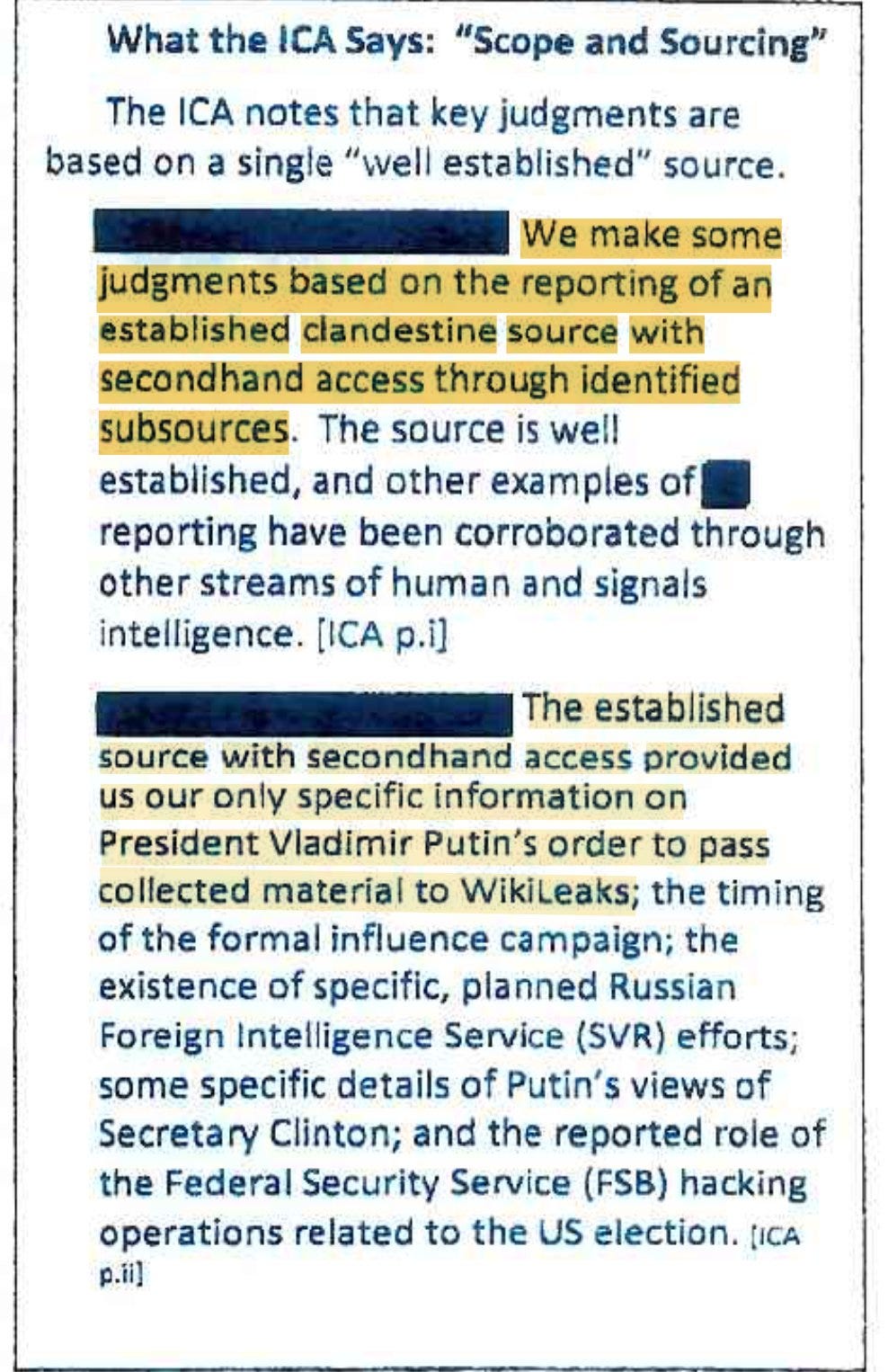In December 2016, the NSA complained that it was denied access to the intelligence used to accuse Russia of hacking and leaking Democratic Party emails. U.S. intel chief James Clapper urged “compromise.”
Three days before the first summit meeting between Donald Trump and Vladimir Putin in July 2018, FBI Special Counsel Robert Mueller accused Russian intelligence officers of hacking and leaking Democratic Party emails to help Trump defeat Hillary Clinton.
Mueller’s conspicuously timed indictment inflamed the all-consuming controversy over Trump’s suspected complicity in a “Russian interference” plot to install him in office. The innuendo reached a fever pitch when Trump stood by Putin at a Helsinki news conference. Before a room of Russiagate-addled journalists on high alert for signs of “collusion” — or a confrontation that could disprove it — Trump said that he believed Putin’s “extremely strong and powerful” denial of meddling in the 2016 election.
Trump’s refusal to accept what was widely portrayed as a US intelligence consensus on Russian meddling triggered a political and media meltdown. CNN anchor Anderson Cooper and Republican Sen. John McCain both agreed that Trump had delivered “one of the most disgraceful performances by an American president” in US history. A former U.S. ambassador to Russia, Michael McFaul, declared that with Trump’s comments, the US was now “in the midst of a national security crisis.” CIA Director turned MSNBC analyst John Brennan decreed that Trump’s heresy was not only impeachment-worthy, but “nothing short of treasonous.”
A newly declassified document released ahead of Friday’s Trump-Putin summit in Alaska adds to a growing body of evidence showing that the US president’s skepticism of “Russian interference” was, in fact, shared at the highest levels of US intelligence.
According to a previously undisclosed email exchange from December 2016, the head of the National Security Agency, Mike Rogers, complained that his analysts were denied access to the intelligence used to blame Russia for the hacking and leaking of Democratic Party material. Rogers sent his dissent to Brennan, the CIA chief; James Clapper, the Director of National Intelligence; and Jim Comey, the FBI Director.
At the time, this small group of national security chiefs, under Brennan’s direction, was rushing to complete a so-called “Intelligence Community Assessment” (ICA). Released on January 6th, 2017, the ICA would accuse Russia with “high confidence” of engineering the hack and leak as part of an “influence campaign” to help Trump. Tasked by President Obama in early December, the ICA was presented as a joint intelligence product from the CIA, FBI, and NSA. But according to Rogers, on the core matter of faulting Russia for Russiagate’s foundational crime, his agency was prevented from weighing the evidence it would need to reach a verdict.
When it comes to the issue of “Russian attribution and intent for the DNC/DCCC hacks,” Rogers wrote on December 22nd, his team had “concerns” that they were not given “sufficient access to the underlying intelligence and sufficient time to review that intelligence.” Accordingly, NSA officials “aren’t fully comfortable saying that they have had enough time to review all of the intelligence to be absolutely confident in their assessments.”
Perhaps to soften the implication that his colleagues at the highest levels of US intelligence were acting deceptively, Rogers added a caveat: “To be clear, I am not saying that we disagree substantively.” But he also made clear that, because the NSA was being marginalized, he was not ready to agree with them publicly: “I do want to make sure that, when we are asked in the future whether we can absolutely stand behind the paper, that we don’t have any reason to hesitate because of the process… If the intent is to create an integrated product that is CIA/FBI/NSA jointly-authored that we can all defend, we need a process that allows us all to be comfortable, and I’m concerned we are not there yet.”
Rogers then suggested that if his fellow national security chiefs were not prepared to share the underlying intelligence used to blame Russia for the DNC/DCCC intrusions, they should release the report without the NSA’s imprint. “In addition, if NSA is intended to be a co-author of this product, I personally expect to see even the most sensitive evidence related to the conclusion,” Rogers wrote. “However, if your intent is to create a ClA-only or CIA/FBI authored product, then I will stand down on these concerns.”


The fact that the head of the National Security Agency threatened to “stand down” from co-authoring the January 2017 ICA carries significant implications.
For one, it shows that despite being billed as a consensus-based intelligence product, the ICA was so closely managed by Brennan that it denied critical access to a named co-author.
It also newly answers a question that I raised in my July 2019 report on the flaws in Mueller’s “Russian interference” allegations: did the allegation of a Russian hack and leak operation rely on evidence from the National Security Agency? As I wrote, invoking former NSA Technical Director Bill Binney, with its sweeping surveillance powers over the global internet, the NSA is “the only U.S. agency that could conclusively determine the source of the alleged DNC email hacks.” Now we know conclusively that the intelligence used to implicate Russia did not come from the NSA – and that the NSA was prevented from assessing its validity.
This new evidence of the NSA’s exclusion in the final ICA process builds on evidence declassified last month by the current DNI, Tulsi Gabbard. In a September 2016 report that was kept from the public for nearly nine years, both the NSA and FBI expressed “low confidence” in the Russian hack and leak allegation. A December 2016 memo privately admitted that US intelligence was relying on forensics provided by CrowdStrike, a firm working directly for the Clinton campaign that later admitted under oath that it “did not have concrete evidence” that alleged Russian hackers stole any data.
A recently declassified House Intelligence (HPSCI) report confirms that there was no new intelligence collected in the ensuing weeks sufficient to change the NSA and FBI’s initial low confidence assessment. “Virtually all significant classified reports cited by the ICA,” the HPSCI report found, were “collected prior to the election.” And the only “new intelligence” cited by the ICA was “paltry.”

As for the ICA’s allegation that Putin ordered that stolen Democratic Party material be passed on to WikiLeaks, a more classified version of the report noted that the “only specific information” came from an “established source with second-hand access.” In other words, another one of Russiagate’s foundational allegations was based on “second-hand” hearsay. (Julian Assange, the WikiLeaks founder, has long denied that Russia was his source. None of the US intelligence, Justice Department, and Congressional investigations of the Trump-Russia affair bothered to interview him.

Piecing these declassifications together, the picture is clear: Given that the NSA had already expressed “low confidence” in the Russian hacking allegation back in September, Brennan and Clapper knew that their “paltry” and “second-hand” intelligence would not suffice to change the NSA’s mind come December. Therefore, to now assert that the intelligence community had “high confidence” of Russian hacking and leaking, as their January 2017 report would claim, Brennan and Clapper ensured that the NSA was denied access to the evidence.
This explains what Clapper told Rogers in response, which has also been newly disclosed.
“We will facilitate as much mutual transparency as possible as we complete the report, but more time is not negotiable,” Clapper wrote. “We may have to compromise on our ‘normal’ modalities, since we must do this on such a compressed schedule.” (emphasis added)
The top US intelligence official was telling the NSA Director that complete “transparency” was not “possible,” and that “normal” standards of evidence would have to be “compromised.”
Clapper then appeared to admit that this “compromise” was necessary to weave a false narrative. He added: “It is essential that we (CIA/NSA/FBI/ODNI) be on the same page, and are all supportive of the report—in the highest tradition of ‘that’s OUR story, and we’re sticking to it.’”
Ultimately, Clapper’s appeal for a unified “story” – evidence and transparency be damned — was successful. Despite the NSA’s voicing of at least two major dissents (in September and then December) on the core Russian hacking claim, Rogers still signed on to the ICA and kept his agency’s objections private. Asked about the new revelations by email, Rogers did not respond by the time of publication.
After getting Rogers to stick to the story for the January 2017 report, Clapper and Brennan received a multi-year assist from a credulous US political and media establishment (not to mention many alternative outlets) that parroted their baseless “Russian interference” allegations and shunned dissenting voices who pointed out the evidentiary holes.
That climate of Russiagate stenography and Cold War fearmongering helped push US-Russia relations to historic lows. With Trump and Putin launching a new round of diplomacy in Alaska, their summit offers a new opportunity to undo the damage of those national security officials who manipulated intelligence, misled the public, and lobbed baseless allegations of treason for questioning their deception.

